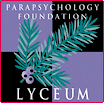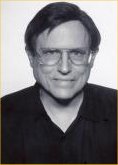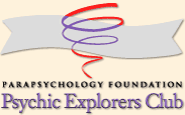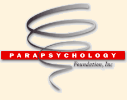 |
 |
| John Palmer  I first became interested in parapsychology after reading a book I stumbled across in my high school library during my senior year. The book was entitled Treatise on Parapsychology by René Sudre. It was divided into two parts. The first part dealt with the card-guessing experiments popularized in the United States by J. B. Rhine. The second part, more tantalizing to me at the time, reviewed research on physical mediumship, complete with photographs of a presumed cellular substance called ectoplasm oozing out of the bodies of trance mediums. I had already developed an interest in the philosophy of mind and wondered why a topic which seemed to have such important philosophical or theoretical implications was not being addressed by psychologists, an attitude that I still hold today. I made parapsychology the theme of my valedictory address at graduation, which included a plea for more research on psychic processes. I first became interested in parapsychology after reading a book I stumbled across in my high school library during my senior year. The book was entitled Treatise on Parapsychology by René Sudre. It was divided into two parts. The first part dealt with the card-guessing experiments popularized in the United States by J. B. Rhine. The second part, more tantalizing to me at the time, reviewed research on physical mediumship, complete with photographs of a presumed cellular substance called ectoplasm oozing out of the bodies of trance mediums. I had already developed an interest in the philosophy of mind and wondered why a topic which seemed to have such important philosophical or theoretical implications was not being addressed by psychologists, an attitude that I still hold today. I made parapsychology the theme of my valedictory address at graduation, which included a plea for more research on psychic processes.
I went to college at Duke University in Durham, North Carolina, majoring in psychology. Although I chose Duke primarily because they gave me financial aid, an added plus was the fact that the Duke Parapsychology Laboratory, shortly thereafter to become the independent Foundation for Research on the Nature of Man (FRNM) and after that the Rhine Research Center (RRC), was located in Durham. This was the lab founded and led by the same J. B. Rhine I had read about in Sudre's book. During my years at Duke I was a “guinea pig” in several experiments at Rhine’s lab, and I got part-time summer jobs as a research worker there following my senior year and after my first year of graduate school. During this time I became greatly impressed with several other young researchers working at FRNM, such as Charles Honorton, Robert Morris, and Rex Stanford, who later became among the most prominent parapsychologists of their (and my) generation. I was particularly impressed that they were applying the methods and concepts of mainstream psychology to the study of psi and could be critical of research that claimed evidence for psi from faulty methodology. I then went on to get my PhD in the psychology of personality at the University of Texas. I did not do anything involving parapsychology at UT, but my knowledge of and fascination with parapsychology was increased by my many conversations with Stanford, who was in his last year of graduate school at UT during my first year there. After graduate school I became an Assistant Professor of Psychology at McGill University in Montreal, Canada. I was looking forward to continuing the research on the psychology of interpersonal attraction that had occupied me at UT, but I found that an inordinate amount of my time was taken up with teaching. Moreover, I didn’t like the teaching, in part because most of the students in the courses I taught were poorly motivated and only were taking them because they were required. In addition, I still had the parapsychology bug. After my second year at McGill an opportunity arose to rejoin Stanford, along with the senior parapsychologists Ian Stevenson and Gaither Pratt, in a pure research job at what was then called the Division of Parapsychology at the University of Virginia Medical Center in Charlottesville. Stevenson was one of the few prominent parapsychologists who was still studying postmortem survival, and I greatly deepened my knowledge of this parapsychological subtopic during my four years there. However, my own research concerned the psychology of out-of-body experiences, which was related only tangentially to the survival issue. During my four years at Virginia I also conducted a random mail survey of psychic experiences and beliefs among several hundred residents of Charlottesville and students at the University. Finally, as a change of pace I joined Pratt in the investigation of two poltergeist cases. My next job was also a research position, working with psychologist and parapsychologist Charles Tart at the University of California, Davis. In addition to assisting Tart with his research testing the hypothesis that ESP could be learned through immediate feedback of the targets in a sequential guessing task, I generalized my research on the out-of-body experience to another altered state, that produced by a sensory-isolation procedure called the ganzfeld. The upshot of all this research was that those participants who claimed the induction procedure worked for them as a group scored more extremely than the other participants on the ESP test in either the positive or negative direction, which direction depending on other, unknown factors. This appointment lasted two years, after which I spent four years supervising the first graduate level degree program in parapsychology in the United States at John F. Kennedy University in Orinda, California. Although this turned out to be primarily a teaching job, the students were highly motivated, and it became a much more pleasant and rewarding experience than my earlier experience at McGill. Several of my students went on to contribute to parapsychology following graduation, most prominently the Parapsychology Foundation’s own Carlos Alvarado. Having moved from the east coast to the west coast of the US, destiny was to increase my range of travels still further. I became a visiting Research Associate for three years in the Department of Psychology at the University of Utrecht, The Netherlands. The head of the parapsychology program in the department was Martin Johnson, a Swedish psychologist/parapsychologist who is best known for developing a psychological test for measuring the presence of psychological defense mechanisms like repression and denial. The test was based in part on how fast participants could recognize the threatening content of pictures presented to them subliminally, that is, below the level of awareness. This led me to begin conducting a series of experiments exploring the hypothesis that subliminal pictures or messages could influence how people score on ESP tests. I continued this research when I returned to North Carolina to work at FRNM, where I stayed for 21 years. This was quite a departure from the brief stints that had characterized my career up to that time, and I eventually rose through the ranks to become their Director of Research. I pursued a variety of different kinds of research during this period, but my interests slowly gravitated toward ESP effects that show up in the absence of any ESP experience or the intention to produce the effects. This type of ESP was brought to the attention of parapsychology in the 1970s by Stanford, when we were together at the University of Virginia. I have coined the label “implicit psi” for this kind of psi, which is the title of a book I hope to write someday. Every summer I also supervised and taught classes in FRNM’s Summer Study Program, an intensive introduction to psi research intended for small groups of highly motivated students representing a variety of backgrounds and nationalities. Finally, since 1994 I have been Editor of the Journal of Parapsychology. My most recent job has once again taken me to Europe, this time working with Peter Brugger in the Department of Neurology at the University of Zürich in Switzerland. Brugger is an open-minded skeptic, and we have been collaborating on research exploring ESP and unconscious learning of biases in ESP target sequences, which Brugger thinks is responsible for positive results in some published ESP experiments. I have been very fortunate to be able to spend most of my career directly and primarily involved in parapsychology, although often this has required that I live off temporary grants, not the most secure existence. As a result, I have moved around a lot. Long-term jobs have always been scarce in parapsychology, but I read in the newspapers that such jobs have become rare in society generally. I also became aware early in my career that parapsychology is frowned upon by academic scientists in mainstream disciplines, especially in my own field of psychology. As a result, I have never bothered to apply for University professorships other than the very few involving parapsychology, although my experience at McGill had decreased my appetite for such jobs anyway. However, other bridges remain unburned. My current grant runs out in March 2006, and if I can't get a parapsychology position my plan is to pursue a job in medical writing or editing with a private communications company. As I am now approaching retirement age, I ask myself whether, if I had it to do over again, I would become a parapsychologist. Absolutely. It’s been a wonderful ride. Part of it is the people. There are exceptions in any field, but by-and-large I find that parapsychologists make fascinating and most congenial colleagues. Perhaps because we are a small “out-group,” parapsychologists have developed close ties to one another, almost like a family. The subject matter is fascinating, and even the controversies, unpleasant as they can be at times, offer the excitement of getting to the core of what science and knowledge are all about. Radical theorizing is not only tolerated but encouraged, although you need to have the evidence before you can consider any of your pet theories to be valid. My main frustration has been the inability to get strong consistent results in my experiments. I seem to specialize in interesting but unexpected (post-hoc) findings that I can’t replicate. I'm not alone in this, but if the case for psi, or any theory of psi, had to rest on my own research, there wouldn’t be much of a case. However, I feel my research has contributed to trends also found by others and thus may be real. On the other hand, there are quite a few parapsychologists who do get strong results consistently, so my fate is far from a fait accompli for others. One implication of implicit psi is that such successful parapsychologists might be unconsciously and unintentionally injecting psi into their own tests of others. Over the years I have gradually (and reluctantly) come to accept this “experimenter psi” as probably real, and it has become a major pillar of my parapsychological theorizing. However, it has not yet been proven scientifically, and there are other ways to account for the success of “gifted” experimenters. Experimenter psi is just another of the cutting-edge theoretical issues that makes being a parapsychologist so exciting — and (most of the time) fun! Palmer, J. (2003). ESP in the ganzfeld: Analysis of a debate. Journal of Consciousness Studies, 10(6-7), 51–68. Palmer, J., & Neppe, V. M. (2003). A controlled analysis of subjective paranormal experiences in temporal lobe dysfunction in a neuropsychiatric population. Journal of Parapsychology, 67, 75–97. Palmer, J. (1997). The challenge of experimenter psi. European Journal of Parapsychology, 13, 110–122. Palmer, J. (1996). External psi influence on ESP task performance. Journal of Parapsychology, 60, 193–210. Palmer, J. (1992). From survival to transcendence: Reflections on psi as anomalous. [Revised version of Presidential Address presented at the meeting of the Parapsychological Association, Las Vegas, NV, August, 1992] Journal of Parapsychology, 56, 229–254. Palmer, J., & Johnson, M. (1991). Defensiveness and brain-hemisphere stimulation in a perceptually mediated ESP task. Journal of Parapsychology, 55, 329–348. Palmer, J. (1988). Conceptualizing the psi controversy. Parapsychology Review, 19(l), 1–5. Palmer, J. (1987). Dulling Occam’s Razor: The role of coherence in assessing scientific knowledge claims. European Journal of Parapsychology, 7, 73–82. Rao, K. R., & Palmer, J. (1987). The anomaly called psi: Recent research and criticism. Behavioral and Brain Sciences, 10, 539–555. Palmer, J. A. (1985). An evaluative report on the current status of parapsychology. Contract DAJA 45-84-M-0405. U.S. Army Research Institute for the Behavioral and Social Sciences, Alexandria, VA. Palmer, J. (1979). A community mail survey of psychic experiences. Journal of the American Society for Psychical Research, 73, 221–251. Palmer, J., Bogart, D. N., Jones, S. M., & Tart, C. T. (1977). Scoring patterns in an ESP ganzfeld experiment. Journal of the American Society for Psychical Research, 71, 122–145. Palmer, J., & Lieberman, R. (1975). The influence of psychological set on ESP and out-of-body experiences. Journal of the American Society for Psychical Research, 69, 235–243. Palmer, J. (1974): A case of RSPK involving a ten-year-old boy: The Powhatan poltergeist. Journal of the American Society for Psychical Research, 68, 1–33. Palmer, J. (1971). Scoring in ESP tests as a function of belief in ESP. Part I. The sheep-goat effect. Journal of the American Society for Psychical Research, 65, 373–408. |
 |

|
 www. parapsychology. org |
||